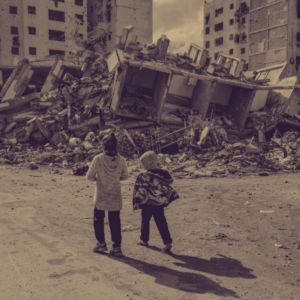
Climate Change Needs to be About Economic Justice
Mary Robinson on the Disproportionate Impact of the Coming Storm
Before Hurricane Katrina hit in August 2005, women in East Biloxi, Mississippi, came to Sharon Hanshaw’s salon on weekend afternoons for socializing and hairstyling. While Sharon flitted between salon chairs—trimming tresses, pleating cornrows, and shaping blowouts—her clientele swapped gossip, read magazines, and waited for their manicures to dry. For 21 years, Sharon’s salon had served as a one-stop shop for women in this coastal city overlooking the warm waters of the Mississippi Sound. While Sharon—wearing one of her signature frosted-blond or auburn wigs—tended to their hair, the women shared stories of broken hearts, of rocky marriages, of struggles with unemployment. Sharon knew that many of her clients had missed out on the economic transformation of Biloxi following the legalization of the garish casinos that now dotted the Mississippi coast. Many more had been hit hard by the closure of the canneries and seafood factories that had once given Biloxi the nickname Seafood Capital of the World. For those women who couldn’t afford Sharon’s prices, she discreetly waived her fees. As the daughter of a Baptist minister, Sharon found it natural that her salon would be a place of refuge in a community rife with racial and economic disparities.
But on the morning of August 29, 2005, the hurricane hit. When the storm made landfall on the Mississippi Gulf Coast, it brought winds of 140 mph and 30-foot storm surges crashing through the streets of East Biloxi. The floods flattened homes along the Biloxi coast, pushing enormous waves of wreckage inland into streets, and tearing apart the predominantly black communities situated on the floodplains. Before the megastorm hit, Sharon was out of town, attending the funeral of a family friend nearly 300 miles away in Aberdeen, northern Mississippi. From there, concerned by news reports about the impending hurricane, she sent for her children. When Sharon finally returned to Biloxi, she found swaths of the city obliterated and Highway 90 fractured, the bridges entering Biloxi buckled and warped. The city’s downtown roads were unnavigable, piled high with broken cars and the splintered remnants of homes and businesses that had come apart in the storm. On Bayview Avenue, Sharon’s salon, ripe with the smell of waterlogged rot and mud, was completely destroyed. Next door, the rental house where she lived was in ruins, the clapboard façade ripped apart, half the roof shorn away, and the rooms knee-deep in a putrid, coagulated mud. Sharon’s red sedan—the rear bumper torn off like a candy wrapper—lay upended against the wall of a nearby government building. The car, submerged in seawater for several days, was unsalvageable. The storm waters had picked up her daughter’s bed and carried it a few doors down, where it lay in someone’s garden.
As Sharon picked her way through the sodden remnants of her home, she salvaged only a handful of photographs and a beloved antique table that had once belonged to her mother. At her daughter’s home, she spent 16 hours hunched over the photographs, determined to preserve some pictorial evidence of her former life. But despite her efforts, the restored photographs showed only the faintest silhouettes. “I wanted to keep them because at least we would know that we did once exist,” Sharon said. The mahogany table—blistered and warped by Gulf water—at first glance seemed unrepairable. Her daughters urged her to throw it away, but Sharon, undeterred, stuck it back together again with superglue. The glue hardened in ugly, lumpy streaks, exacerbating the table’s sorry state.
Hurricane Katrina—and the catastrophic failure of the levees at the Industrial Canal and Lake Pontchartrain that would submerge 80 percent of New Orleans—caused more than 1,800 deaths along the U.S. Southern coast and damaged or destroyed more than a million homes and businesses. It displaced more than a million people, including 175,000 African American residents in New Orleans. Following the hurricane, most of the media coverage focused on New Orleans, but the destruction was just as bad, if not worse, in other places along the Gulf Coast. In Mississippi, the storm left more than 100,000 people homeless, put thousands more out of work, and caused in excess of $25 billion in damage. Biloxi, situated on a low-lying peninsula and floodplain, was devastated.
In East Biloxi, where Sharon lived, the storm destroyed or damaged more than 5,000 homes, ravaging neighborhoods and scattering families.
For five months, Sharon lived with her daughter in Gulfport, Mississippi, until she received a government-issued FEMA trailer back in East Biloxi. Returning to her neighborhood, Sharon was shocked to discover that the streets still resembled a war zone. Rancid piles of fly-infested debris, festering in the swampy heat, lined street corners. Rotting refrigerators, mattresses, and piles of moldy clothes waited for trash collections that never came. Water and electricity supplies were erratic, and functioning grocery stores scarce. Thousands of East Biloxi’s residents remained homeless.
Through the diminished neighborhood grapevine, Sharon heard angry whisperings that property developers and casino owners were dominating the recovery process, lobbying officials to rebuild damaged casinos before homes. Immediately after the storm, Mississippi governor Haley Barbour persuaded Congress to award Mississippi a federal disaster aid package of $5 billion. But despite this unprecedented sum, there were indications that Sharon and other low-income residents of Mississippi would be left behind in the recovery, that assistance would be limited to homeowners with insurance. Renters such as Sharon—in addition to residents whose homes had suffered wind damage—were deemed ineligible for aid. She was outraged but did not know where to turn. Then, in January 2006, she learned about a meeting to be held in one of the few undamaged buildings in Biloxi, a funeral home across town. The following Monday night Sharon hitchhiked across Biloxi and found about 50 women—white, black, Latino, and American Vietnamese—sitting around a large table. “The women were broken-down, they had lost family members,” Sharon remembers. “No one had jobs. We had just the bare necessities. Everyone was saying, ‘We’ve got to do something.’”
For those who live in predominantly low-income or minority neighborhoods, the chances are that you, and your family, will be more severely impacted by the effects of climate change than those living in wealthier communities. As the post-Katrina devastation in New Orleans and along the Gulf Coast showed, the storm’s impacts weighed more heavily upon racial minorities and the poor. Before Katrina slammed into the Mississippi coast, the state ranked first in poverty rates in the United States and had the second-lowest state median household income. The hurricane devastated a 90-mile coast that reflected the racially segregated division of neighborhoods that had emerged in the wake of the Civil War, when African Americans were forced to reside in undesirable swampland areas prone to frequent flooding and rife with poor sanitation and unhealthy conditions. Along the Mississippi coast, “out-of-town” low-value neighborhoods sat behind the railway line that ran from New Orleans to Mobile, Alabama, creating a racial dividing line that separated these black neighborhoods from the beachfront homes belonging to wealthy white families.
Similar patterns exist across the rest of the United States, where new evidence suggests that major cities—Boston, New York, and Miami among others—are at risk of catastrophic flooding if sea levels continue to rise, and that low-income residents of these cities living in subsidized waterfront housing will be at greatest risk. When Hurricane Sandy slammed into New York City in October 2012, many of the wealthier residents could ride out the storm in Manhattan hotels or flee inland by car. But for New York City’s lower-income residents—many of whom live in apartments on flood-prone waterfront land—the storm proved devastating.
On America’s West Coast, researchers have found that African Americans living in Los Angeles are almost twice as likely to die as other residents of the city during a heat wave. Less likely to have access to air-conditioning, and more likely to live in buildings constructed from materials that retain heat, these inner-city residents are more susceptible to the “heat island” effect, in which heat generated by asphalt can exacerbate temperatures. Inner-city residents are also more likely to breathe dirtier air and lack access to health insurance and proper medical care. As our planet continues to warm and smoggy conditions increase, those living in low-income parts of cities will inevitably suffer the most. The poor do not have the economic conditions that allow them to be resilient in climate hazards, nor can they often choose to leave their disadvantaged areas. Policymakers tackling climate change must acknowledge these injustices for urban and minority communities caught in the crosshairs of climate change. If not, these racial disparities and economic disadvantages will only widen an already gargantuan climate gap.
![]()

From Climate Justice by Mary Robinson, courtesy Bloomsbury. Copyright 2018, Mary Robinson.
Mary Robinson
Mary Robinson served as the seventh, and first female, president of Ireland from 1990-1997, and as United Nations High Commissioner for Human Rights from 1997-2002. Robinson has been honorary president of Oxfam International since 2002, and has chaired numerous bodies, including the GAVI Alliance, vaccinating children worldwide, and the Council of Women World Leaders (of which she was a cofounder). She is a member of the Elders, an independent group of global leaders brought together by Nelson Mandela. A member of the American Philosophical Society, she is the recipient of numerous awards and honors, including the U.S. Presidential Medal of Freedom and the Indira Gandhi and Sydney Peace Prizes. She is president of the Mary Robinson Foundation-Climate Justice, and lives with her husband, Nick Robinson, in Dublin and Mayo.



















